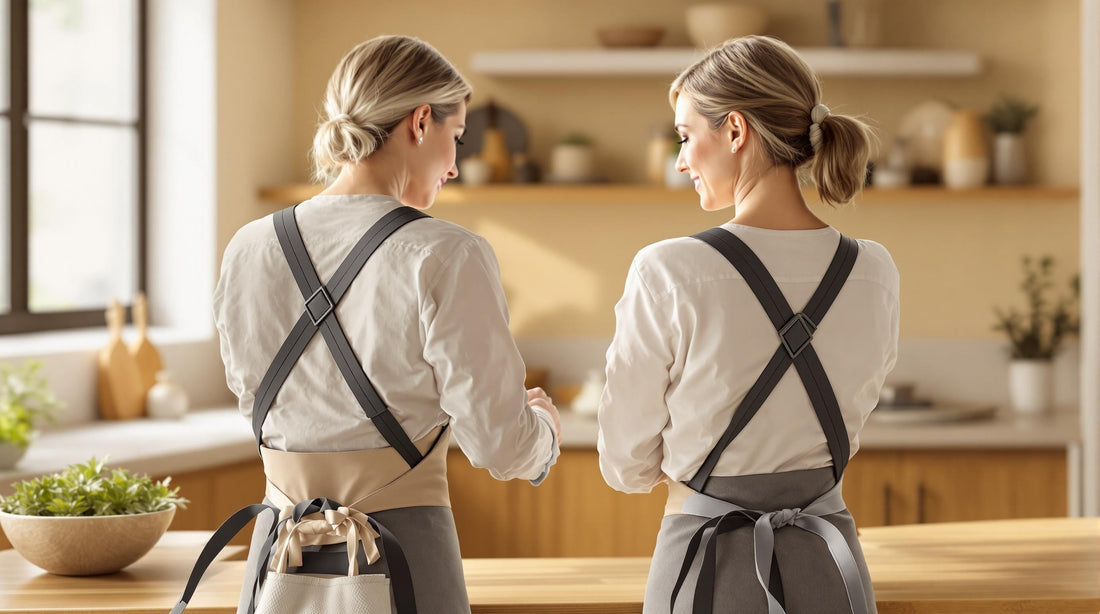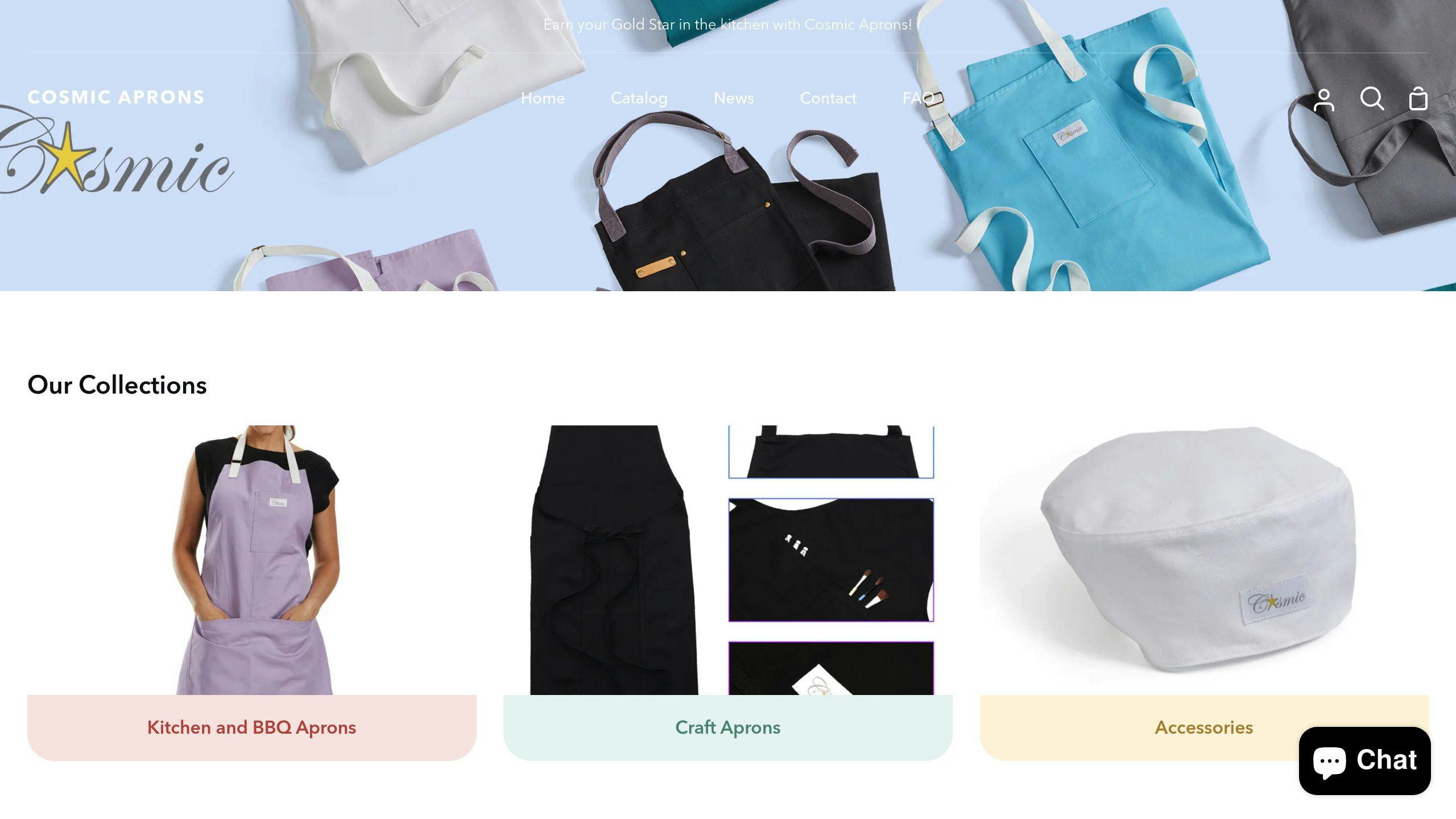
How to Adjust Apron Straps for Better Back Support
Share
Want better back support while wearing an apron? Start by adjusting the straps to distribute weight evenly across your shoulders, not your neck. Poorly adjusted aprons can cause neck and back strain, especially during long hours of use. Here’s what you need to know:
- Choose the right strap design: Cross-back straps are best for even weight distribution. Loop-neck straps can strain your neck.
- Adjust properly: Position the bib 1–2 inches below your collarbone and tighten straps evenly. Secure waist straps snugly at your natural waist.
- Look for features: Adjustable, padded straps and elastic back panels improve comfort and reduce strain.
- Check regularly: Straps can stretch over time - readjust as needed for ongoing support.
For lasting comfort, consider aprons with ergonomic designs like those from Cosmic Aprons. Proper strap adjustment can protect your back and improve posture during extended wear.
Crossback Aprons - Instructions
Understanding Apron Strap Ergonomics
The design and placement of apron straps play a key role in how weight is distributed and how your posture holds up over time. Poorly designed straps can create pressure points, leading to discomfort and possibly long-term issues. Knowing the differences in strap designs can help you pick the right apron for your needs.
Strap Design and Back Support
Strap designs vary in how they provide support and comfort:
- Loop-neck straps focus the weight on your neck, making them better for short-term use.
- Cross-back straps spread the weight evenly across your shoulders, offering a natural support system that reduces strain.
- Y-strap designs combine shoulder and hip support, making them a solid choice for professionals.
Cross-back straps are particularly good at reducing strain, but their performance relies on proper adjustment to balance the weight evenly across your shoulders and back [1]. Brands like Cosmic Aprons integrate ergonomic designs with adjustable features to cater to both professional and casual users.
Features of Adjustable Apron Straps
Modern aprons often come with features that boost both support and comfort. These include sliding adjusters, padded sections, and quick-release buckles [2]. Padded straps are especially helpful for chefs who spend long hours on their feet, providing much-needed cushioning during extended shifts [3].
The appeal of adjustable straps lies in their ability to fit your body and tasks. When adjusted correctly, they distribute weight evenly across your shoulders and back [1], avoiding the neck strain often caused by traditional designs.
With a better understanding of strap ergonomics, you're ready to learn how to adjust them for maximum comfort and support.
sbb-itb-c693c43
Guide: Adjusting Apron Straps
Getting your apron straps adjusted correctly is key to distributing weight evenly and avoiding unnecessary strain.
1: Identify Your Apron's Strap Type
Start by figuring out what type of straps your apron has. Are they a simple loop around your neck, crossing at the back, or forming a Y-shape? Each design needs a slightly different approach to get the fit just right.
Here are the most common strap types:
| Strap Type | Adjustment Points |
|---|---|
| Loop-neck | Single neck strap |
| Cross-back | Two shoulder straps |
| Y-strap | Shoulder and hip straps |
2: Adjust Neck and Waist Straps
For loop-neck straps, loosen the neck strap and position the bib about 1–2 inches below your collarbone. Tighten it enough to feel secure but not restrictive.
For cross-back straps, loosen both shoulder straps first. Place the bib against your chest and pull the straps across your back, ensuring they lie flat. Adjust the length evenly so the tension is balanced on both shoulders.
Finally, tie the waist straps snugly at your natural waist (the narrowest part of your torso). This keeps the apron in place without limiting your movement.
3: Modify Straps as Needed
If your apron doesn’t have adjustable straps, you can add quick-release buckles to make it easier to customize the fit.
Pro tip: Over time, fabric can stretch, especially during long shifts in a professional kitchen. Check and readjust your straps every few hours to maintain comfort and support.
For aprons with adjustable back panels, make sure the weight is evenly distributed between your shoulders and hips [3].
With these adjustments, your apron will feel more comfortable and supportive throughout the day.
Choosing an Apron for Comfort and Support
Picking the right apron can make a big difference, especially when it comes to comfort and back support during long hours of use. Here’s what to look for.
Look for Adjustable and Padded Straps
Choose aprons with features like wide, padded straps, elastic back panels, and cross-back designs. These elements help distribute weight evenly, reduce strain, and offer better support for your back during extended wear [2][3].
| Feature | Benefit |
|---|---|
| Cross-back straps | Spreads weight evenly across your shoulders |
| Padded neck support | Eases strain on neck muscles |
| Elastic back panels | Supports your lower back during movement |
When trying on an apron, go for one that’s slightly larger than your usual size. This ensures you have enough room to move freely without losing the support you need. A snug fit is ideal, but it shouldn't create pressure points.
Cosmic Aprons: A Trusted Choice

Cosmic Aprons offers a range of ergonomic designs suited for both professional and home cooking. Their aprons come with adjustable straps, thoughtfully placed pockets, and cross-back styles designed to keep tools balanced while reducing strain.
Their durable designs include reinforced attachments and multiple adjustment points, so you can customize the fit for maximum comfort. Once you’ve chosen the right apron, adjusting the straps properly will help you get the best support and comfort possible.
Conclusion: Adjusting Straps for Better Back Support
Properly adjusting apron straps can help reduce back strain, improve posture, and keep you comfortable during extended use. The key is to evenly distribute the weight across your shoulders and secure the apron without causing tension or pressure points. Make sure the bib sits comfortably on your chest, and tie the waist straps snugly but without discomfort.
For better support, look for aprons with features like adjustable cross-back designs. Brands like Cosmic Aprons offer durable options that make it easier to maintain good posture while cooking or crafting for long periods.
A properly adjusted apron should:
- Sit evenly on your shoulders for balance
- Stay in place while allowing easy movement
- Provide support for your lower back when bending or reaching
